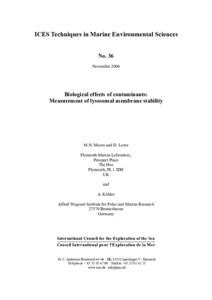| dc.contributor.author | Moore, M.N. | |
| dc.contributor.author | Lowe, D. | |
| dc.contributor.author | Köhler, A. | |
| dc.date.accessioned | 2019-01-12T21:44:37Z | |
| dc.date.available | 2019-01-12T21:44:37Z | |
| dc.date.issued | 2004 | |
| dc.identifier.citation | Moore, M.N.; Lowe,D. and Köhler, A. (2004) Biological effects of contaminants: measurement of lysosomal membrane stability. ICES Techniques in Marine Environmental Sciences, No. 36. 31pp. DOI: http://dx.doi.org/10.25607/OBP-227 | en_US |
| dc.identifier.issn | 0903–2606 | |
| dc.identifier.uri | http://hdl.handle.net/11329/670 | |
| dc.identifier.uri | http://dx.doi.org/10.25607/OBP-227 | |
| dc.description.abstract | Lysosomes are ubiquitous cellular organelles that provide a waste disposal and macromolecular
recycling system (autophagy) and also a membrane-bound compartment for intracellular
digestion of food ingested by the cells. They accumulate many toxic metals and organic
chemical contaminants, providing an evolutionarily primitive detoxication capacity, which if
overloaded results in lysosomal damage leading to cell injury, tissue dysfunction, and reduction
in animal “health status”. Major reactions of lysosomes to pollutants include loss of membrane
integrity, enlargement associated with autophagy, and accumulation of lipid and lipofuscin (agepigment).
These types of responses have been widely used to test for the effects of toxic
contaminants in both experimental investigations and environmental impact assessments.
Several methods are available to measure lysosomal functional status: these include
measurement of lysosomal membrane stability in both frozen tissue sections and live cells.
Protocols for the implementation of these methods are described here in practical detail for
mussel/molluscan digestive gland or hepatopancreas and flatfish liver. Cytochemically
determined latency of selected lysosomal marker enzymes is used as the measure of stability in
frozen sections, and retention time of the chromogenic dye neutral red, as the measure of
lysosomal integrity in live cells. Guidelines are included for sample handling, data analysis, and
interpretation of results | en_US |
| dc.language.iso | en | en_US |
| dc.publisher | International Council for the Exploration of the Sea (ICES) | en_US |
| dc.relation.ispartofseries | ICES Techniques in Marine Environmental Sciences;36 | |
| dc.subject.other | Lysosomes | en_US |
| dc.subject.other | Organic chemical contaminants | en_US |
| dc.subject.other | Autophagy | en_US |
| dc.subject.other | Lipofuscin | en_US |
| dc.subject.other | Digestive glands | en_US |
| dc.subject.other | Flatfish | en_US |
| dc.subject.other | Liver | en_US |
| dc.title | Biological effects of contaminants: measurement of lysosomal membrane stability. | en_US |
| dc.type | Report | en_US |
| dc.description.status | Published | en_US |
| dc.format.pages | 31pp. | en_US |
| dc.description.refereed | Refereed | en_US |
| dc.publisher.place | Copenhagen, Denmark | en_US |
| dc.subject.parameterDiscipline | Parameter Discipline::Biological oceanography::Other biological measurements | en_US |
| dc.description.currentstatus | Current | en_US |
| dc.description.sdg | 14.A | en_US |
| dc.description.sdg | 14.1 | |
| dc.description.eov | Microbe biomass and diversity | en_US |
| dc.description.bptype | Standard Operating Procedure | en_US |
| dc.description.bptype | Guide | en_US |
| obps.contact.contactemail | info@ices.dk | |
| obps.resourceurl.publisher | http://ices.dk/publications/library/ | en_US |
 Repository of community practices in Ocean Research, Applications and Data/Information Management
Repository of community practices in Ocean Research, Applications and Data/Information Management
